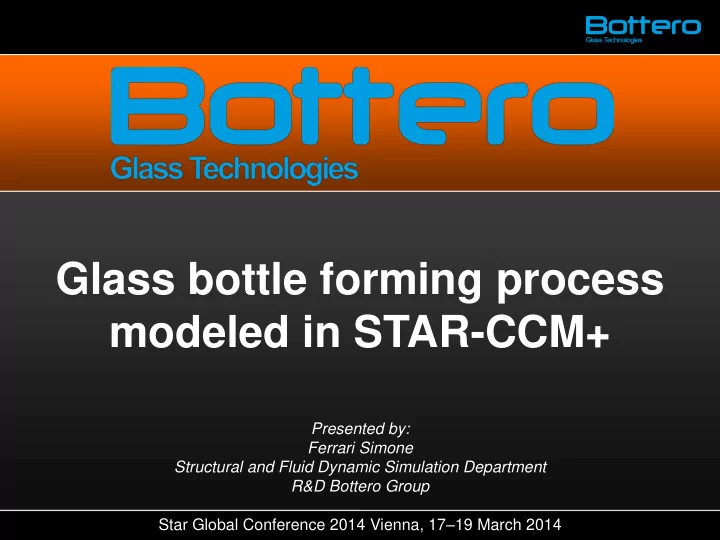

Glass bottle forming process modeled in STAR-CCM+ Presented by: Ferrari Simone Structural and Fluid Dynamic Simulation Department R&D Bottero Group Star Global Conference 2014 Vienna, 17 – 19 March 2014
Agenda
Company profile Italy Cuneo – ( Headquarter) Trana Vicenza Treviso Pesaro France St. Jeannet Germany Grevenbroich Donauwörth United Kingdom Rochdale
Company profile China Shanghai Foshan Bengbu USA Kernesville Brasile Diadema
Bottero business and products Business and products Hollow Glass Flat Glass Special trailers COMETTO industries
Focus on Hollow Glass Division Hollow Glass Offers a complete range for glass forming from fore-hearths to lehr Glass Conditioning Gob Forming Container Forming Ware Handling
Focus on Hollow Glass Division Glass Conditioning Gob Forming Container Forming
Container Forming Cycle Press & Blow process 1 The gob is guided into a blank mold A plunger rises from the neck side and 2 presses the gob forming the “Parison” The mold opens and the partially formed 3 container is released and inverted through 180 degrees The container is transferred to the blow 4 mold Air is injected to blow the container into 5 shape Finished container 6
Bottero E-MOC Blank Blank and and Mold old Mec echa hanism nism Innovation in glass industry Top mounted Parallel Molds motion Retrofittable IS mold compatible 360 ° Axial and Radial Cooling
Glass Viscosity vs. T
Glass Bottle Forming IR Thermo-Measurement Forming steps Simulation Steps Step 1 Step 2 Step 3 Step 4 Blank Side Invert Mechanism Blow Side Blow Side Parison Forming Reheating Stretching Bottle Forming
Step 1) Blank Side – Parison Forming Volume Temperature Distribution Equipment Thermal Images Steady State Simulation Plunger Conjugate Heat Transfer Simulation: Neck-Ring • Input: T Glass Gob • Conduction and Radiation • Physical Material Blank Properties Mold • Unsteady: Time = Machine Timing Parison
Step 1) Blank Side – Parison Forming
Step 2) Invert Mechanism – Reheating ... to Blow Side From Blank Side... Rotation 180 ° Conjugate Heat Transfer Simulation: • T Glass from Step 1 • Air Convection: T Air • Conduction and Radiation • Unsteady: Time = Machine Timing
Step 2) Invert Mechanism – Reheating ... to Blow Side From Blank Side... Rotation 180 ° Soft Parison Hard Parison Ready to stretch… Parison surface Temperature
Step 3) Blow Side – Stretching VOF Simulation 3D • 2 Phases: Glass and Air • Conduction and Air Convection • Gravity • Unsteady: Time = Machine Timing Input: Input: 3D Temperature Distribution from the Viscosity (T) Reheating Step
Step 3) Blow Side – Stretching Physical Interpretation Gravity, Conduction, Temperature, Viscosity…
Step 3) Blow Side – Stretching Stretching extremely depends on: • Parison Design • Process Variables (e.g. Molten Glass T, Molds Contact time) Simulation 5 ° C higher T Higher Molten Glass T 0 0 0 0 0 0 0 0 0 0 0 0 0 0 0 0 0 0 0
Step 4) Blow Side – Bottle Forming Blow Head VOF Simulation Vacuum Holes • Blow Pressure • Vacuum Pressure • Unsteady: Time = Machine Timing
Step 4) Blow Side – Bottle Forming
Final Bottle Results Thickness Profile • Compromise between structural properties and bottle weight • Stretching is the Key-Step Simulation Measure
Conclusions CONCLUSIONS • Simulation is based on physical parameters in both thermal and dynamic properties • The VOF model handles glass viscosity from liquid (100 P) to solid (10 9 P) with high time-steps • The simulation variables are the machine settings (e.g. cycle timing, molten glass T) • Application cases: - Parison Design to reduce the trials on molds and on machines - Effects of non-idealities on process variables Next goal is the optimization of the entire forming process to reach faster production and lighter bottles
Questions?
Recommend
More recommend